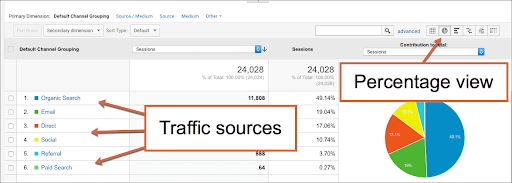Having spoken to hundreds of business owners & marketers during this time, one common theme is raised time and time again, when discussing specific KPIs & business objectives: “I want to rank on Page 1 of Google.”
While this may be a common and mutual goal for many business owners alike, when discussing expected SEO KPIs, we have formulated a winning SEO philosophy, containing six main foundational pillars of focus, that can help ensure your SEO strategy is on point to climb the search engine results page (SERPs).
Technical SEO
To win at SEO, you firstly need a well optimized website. Creating a strong technical SEO foundation for your website will not only satisfy your users, enabling them to find what they are looking for with greater ease, but also allow search engines to crawl your site easier, which will help to prioritize your site over others.
Focus items may include taking a closer look at the overall architecture & HTML of your website. Ask yourself the following questions and seek to answer them through some below free resource tools I have included:
Architecture
- Crawl – Can search engines easily crawl pages on your website?
- Devices – Does your site perform well on all device types including mobile?
- Speed/Performance – Does your website load quickly?
- URLs – Are URLs properly structured, so search engines can easily read?
- HTTPS – Does your website use HTTPS to provide security to visitors?
HTML
- Page Titles – Do your title tags contain the right keywords you are looking to rank against & are they formatted correctly (i.e. Primary Keyword | Secondary Keyword | Brand Name)?
- Descriptions – Does each webpage have a unique meta description to entice users to click through to your site directly from the SERPs?
- Headings – Are you properly using headings to structure the content on each of your pages for greater readability?
Useful Tools: Google’s PageSpeed Insights, seoQuake, Detailed SEO Extension
Content
Content is king when it comes to SEO, period. You need content that is greater and better optimized than the top ranking results listed within the SERPs. It may be great that you have a technically sound website, however, if the content does not accurately match a user’s intent when browsing the web for similar products/services your business may offer, you face a significant gap.
Google’s algorithms are constantly evolving in an effort to provide users with the best possible results that match their search intent at any given time. Google’s mission since day 1 has been to; “Organize the world’s information and make it universally accessible and useful.” Therefore, understanding the type of inquiries users are searching for, and the top results displayed against these search inquiries at any given time, will go a long way in aiding your business to map out a supporting SEO content strategy.
Julia McCoy from searchengingejournal.com says it best; “If you want organic visibility, rankings, and traffic, you have to commit yourself to the grind of consistently creating optimized content.” Start off by conducting some preliminary market research to determine possible content opportunities based on the inquiries users are searching for in relation to your business.
Useful Tools: Google Keyword Planner, Aherfs Keyword Generator & SEMRush’s Keyword Magic Tool, SEMRush Topic Research Content Tool
Backlinks
Backlinks or link building, has been a crucial part of SEO since inception. While my colleague Alex Belanger, has written a previous article specific to The Evolution of Link Building, backlinks in general build business credibility and support the expertise that your business claims to have acquired. Think of it this way, a backlink is similar to one website providing a recommendation to another. Therefore if you have highly reputable or authoritative websites referencing and pointing users back to your site, you are now not only claiming to have business expertise within a particular topic/field, but rather you have other websites reinforcing this claimed expertise of your business as well.
Useful Tools: Majestic, Whitespark, HARO
User Metrics
Your website may have sound technical SEO, frequently produced content, and great supporting backlinks. However if your website is not easily navigable and provides your users with an amazing on-site experience, they will inevitably abandon and leave your site.
Ask yourself the following questions:
- Does my website load in three seconds or less?
- Does my navigational menu make it easy for my customers to find what they may be looking for while on my site?
- Does my website look professional and provide customers with confidence/trust in my business?
As you think about the above, you may have existing tools readily available at your disposal to help you understand how users are interacting with the content on your website. For example, within Google Analytics, you can easily access exit page metrics. Log in to to your Google Analytics account and navigate to Behaviour > Site Content > All Pages. Here you will then be able to see the specific page URLs and exit percentage for each page across your site. Looking at this data, alongside other tools such as heatmaps to visually track user activity on site will allow you to make informed business decisions, improve user time on site, and generate more favourable actions from these web visitors.

Useful Tools: Google Analytics, Hotjar (Heat maps), Lighthouse (Core Web Vitals)
Traffic
At the end of the day, direct traffic to your website shows search engines that you are popular. While direct traffic does not directly impact your search rankings, it act as a positive search signal. For websites that currently receive little to minimal traffic, boosting web traffic from other sources such as running a small traffic focused paid ads campaign, or leaning on your social channels to drive meaningful engagement and click-through traffic, may be the key to jump starting an SEO campaign and building greater initial organic site traffic for your business.
Through Google Analytics, you can easily navigate and see the various traffic sources driving web visitors to your site.
Google Analytics > Acquisition > All traffic > Channels

Online Properties/Reputation
Finally, your website may have strong technical SEO practices in place, a robust content strategy, sufficient and high-quality backlinks, outstanding user metrics, and adequate traffic flowing through to your website…..so now what?
The last remaining piece of our SEO philosophy relates to both your businesses online properties and business reputation. Educated consumers will take the time to check out your business reviews, as well as various social media outlets, to see what your customers are saying about your business prior to making a purchase decision or completing any action through lead magnets.
If you are not engaging with your customers, good or bad, as well as having an active presence across all social channels your business is present on, you are likely losing out on potential customers.
Setting up a Google My Business listing for your business, responding to customer reviews, and keeping the conversation going with your customers across active social media channels, will all assist in putting your best foot forward when it comes to running a successful SEO campaign.
Outsourcing or managing an impactful SEO campaign in-house can be a difficult challenge. What may work today, may no longer be effective tomorrow. According to WebFX, more than 50% of all website traffic is driven through organic search. This is more than any other traffic source….. By far! That leaves the question, why would you not put an emphasis on SEO within your digital marketing strategy?
Digital & Social Articles on Business 2 Community
(48)






